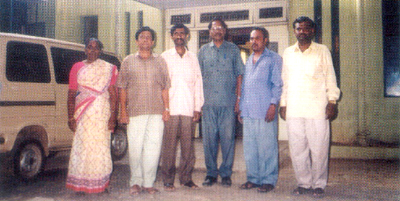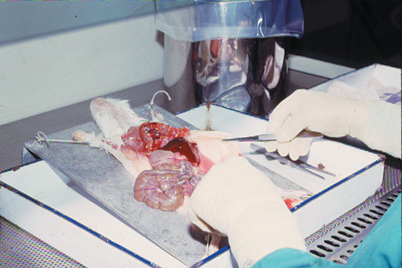4. THE WORK OF TWO DECADES
4.7. The animal house facility
 Animal House |
Establishment of animal house in 1977 was another example of the foresight of the NTI. It is a well established fact that experiments in animal models have contributed significantly to the battle against human TB right from the discovery of tubercle bacilli by Robert Koch in the year 1889. The necessity of the animal house at NTI was felt just after the establishment of its bacteriology section when the sputum samples in large number started arriving from the research field areas. In 1962 a proposal was submitted to the GOI for creation of an animal house114. It took about 15 years before Central Public Works Department (CPWD) could hand over the building to NTI. Just after its establishment, a scientific meting was held under the chairmanship of Dr NK Menon, Director, NTI. It was attended by Dr BNM Barua, Adviser in TB, Dr K Padmanabha Rao, former Senior Bacteriologist and Dr N Naganathan, Jr Bacteriologist of NTI, who chalked out the plans for future experiments in laboratory animals and their utility in TB control. Later in October 1979 when Dr KN Tandon, Veterinarian joined the Institute, the breeding wing of the animal house became operational with the procurement of initial stock of three guinea pigs, six rabbits and four hamsters from Indian Institute of Science (IISc), Bangalore. In May 1981, Dr Naganathan, with the assistance of Dr Tandon, Veterinarian initiated the experimental work on a modest scale in the northern wing of animal house which was cardoned off with suitable modifications and installation of essential equipments like autoclave and incinerator.Verysoon, Dr Tandon left NTI but preliminary experimental work which included standardisation of techniques in getting familiarised with the experimental procedures and finding out the suitability of a particular laboratory animal as animal model for TB, continued. It was decided that the albino guinea pig is ideal for this purpose. The breeding of other animals was discontinued thereafter. Subsequently, full-fledged research projects involving guinea pigs for animal experimentations were started. Prof. Donald W Smith of University of Wisconsin Madison, USA along with Dr GVJ Baily, Director played a key role in the above policy making decisions. Dr VK Challu joined as Veterinarian in June 1983. This further strengthened the activities of animal house. The highlights of some of the studies is briefly described as under :
|
The Institute entered the 21st year with a happy
augury; the animal house commenced its activities. No doubt it has
started humbly, yet there is no denying the fact that new dimensions
are going to be added to our research in the near future. |
 Dr. N. Naganathan Jr. Bacteriologist |
Between 1982 and 1986, a study on significance of virulence of tubercle bacilli in animal model was conducted. This revealed isolation of high virulent tubercle bacilli from TB meningitis patients cerebrospinal fluid in contrast to cavitory pulmonary TB patients sputum, where majority of them excreted low virulent tubercle bacilli115. In another study carried out between 1985 and 1988, isolates of M.tb from the urine and sputum of pulmonary TB patients were found to differ in their virulence, phage type and drug sensitivity pattern in a significant number of cases116. This prompted for further investigations to understand the key events in the pathogenesis of TB leading to the development of cavitory lesions. Low virulent character of tubercle bacilli termed as ‘south Indian variant’ was interestingly found to remain unchanged during eight years of animal passage from 1984 to 1992 in albino guinea pig animal model117. Experiments on evaluation of protective effect of BCG and role of environmental mycobacterial infection was also initiated. This was followed by improvisation for assessing the virulence of tubercle bacilli in animal model by a quantitative measurement which would be reproducible in different laboratories irrespective of the investigators 118,119.
Animal experiments carried out in the institute have also been assisting other research organisations in evaluating new antigens, preparation of immunotherapeutic agents and new antigenic preparations. Currently, experiments carried out at the institute involved T-cell proliferative response to M.tb sonicate and protective efficacy of (plasmid DNA encoding recombinant protein)/vector DNA; testing of coded purified mycobacterial antigen against challenge with high virulent bacilli; behaviour of INH drug resistant tubercle bacilli, etc. During the later part of 1990s, techniques and procedures for the immunological studies involving animal experimentation have been standardised in collaboration with the scientists from Centre for Genetic Engineering, IISc, Bangalore.
 Animal Experimentation |
In 1998, the animal house was redesignated as Animal Model Research Unit (AMRU). The necessity arose not due to change in its functions but because of worldwide movement of environment and animal protection. Another ongoing collaborative study involving animal experiments is on ‘Regulation of gyrase gene expression, invivo function of DNA gyrase and effect of gyrase expression on virulence of virulent related genes’ – a long term project on structure – function mechanism of action and regulation of DNA gyrase from mycobacteria has already been initiated at IISc, Bangalore.
The establishment of bio-safety level III facility also known as P-3 facility at AMRU, utilising the unique low dose aerosol infection system is under progress. Prof Donald W Smith of Wisconsin university on the eve of his retirement gifted the P-3 laboratory equipment to NTI. This facility will help in carrying out studies in human beings aimed at better understanding of the key events of TB pathogenesis and the effective and innovative interventions to win over the TB problem. With introduction of low dose aerosal infection system, the infection produced in animal model will reflect very closely to TB infection caused in human beings. It will also help in reducing the number of animals used for the research. Besides invitro experiments will continue as complimentary methods.